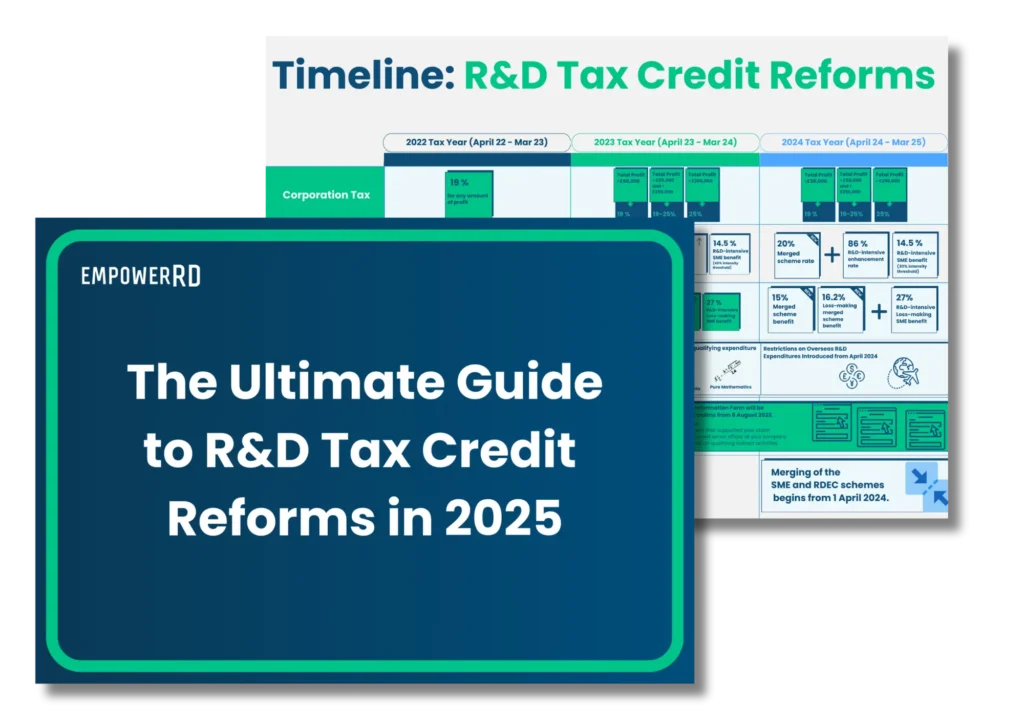A new low for error and fraud: what does it mean for innovators?
For the second consecutive year, HMRC’s annual report, published on the 17th July, shows a reduction in error and fraud in R&D tax relief – dropping to 5.9%, down from 7.8% in 2023-24 and 17.6% in 2021-22.
The latest statistics show HMRC’s compliance efforts are working. It’s a step in the right direction, but one that raises new questions for startups navigating an increasingly complex scheme.
However, these improvements do raise important questions about its broader implications for startups, particularly on the increasing complexity of claims and the future direction of the scheme.
The numbers: A breakdown of HMRC’s latest error and fraud estimates
Overall R&D Tax Relief Scheme:
- 2024–25: 5.9% error/fraud rate (£481 million)
- 2023–24: 7.8%
- 2021–22: 17.6% (£1.34 billion)
SME Scheme:
- 2024–25: 10.6% error/fraud (£339 million)
- 2022–23: 14.7% (£652 million)
- 2021–22: 25.8% (£1.20 billion)
RDEC Scheme:
- 2024–25: 2.4% error/fraud (£70 million)
- 2022–23: 3.3% (£107 million)
- 2021–22: 4.6% (£130 million)
The largest reduction has come from the SME scheme, which was historically the area of greatest concern for HMRC, responsible for £1.2 billion of losses in 21-22 alone.
However, the targeted interventions like the Additional Information Form (AIF), Claim Notification Form (CNF) and Mandatory Random Enquiry Programme (MREP) have clearly helped by introducing more structured oversight and reduced opportunities for incorrect or invalid submissions, reducing the overall cost of error and fraud by £861 million over three years.
What’s Driving the Improvement?
Recent HMRC reforms have improved the integrity and transparency of the R&D tax credit scheme. These measures make it easier to identify weak claims, combat fraudulent claims from being submitted, hold advisors accountable, and ensure robust oversight. Here’s how:
1. The Additional Information Form (AIF):
Introduced in August 2023, the AIF requires every claim to include a detailed breakdown of R&D projects, associated costs, and the party responsible for preparing the claim. This added layer of detail helps HMRC quickly flag vague or unsupported submissions.
2. The Mandatory Random Enquiry Programme (MREP):
MREP enables HMRC to review a random sample of claims, providing valuable insights into how the scheme is being used. This initiative allows HMRC to identify risks, refine their processes, and discourage poorly prepared claims.
3. Digital-Only Submissions:
From April 2023, all R&D claims must be submitted digitally. This shift reduces processing errors and ensures consistent data for HMRC’s evaluation, streamlining the overall assessment process.
4. Advisor Disclosure Requirements:
Claimants are now required to disclose the names of any advisors involved in preparing their claims. This allows HMRC to track patterns and take action against advisors submitting subpar or high-risk claims.
Together, these reforms have strengthened the framework of the R&D tax credit scheme, reduced error and fraud rates, and delivered much-needed structure to the process.
Has HMRC swung the pendulum too far?
The R&D tax relief scheme needed reform and the amount of money lost to error and fraud was unacceptable. However, with error and fraud at a more manageable level, now is a good time to look at how HMRC can improve the process for startups and small claimants.
Whilst the Additional Information Form (AIF) and the introduction of the MREP has seen positive results, it has also created real challenges. These changes have created friction and increased pressure on businesses.
In some cases, genuine claimants are opting out of the scheme altogether or even looking beyond the UK. The reason for this? the time and resources now required, the complexity of the process and the fear of an enquiry outweighing the potential monetary gain.
On top of this, HMRC’s analysis assumes all withdrawn claims translate to error and fraud, which is overstating the issue. For instance, a lot of time-poor businesses are simply abandoning a claim because of the cost and time it takes to defend one.
Rob Whiteside, our CEO, explains:
“UK founders are ready to innovate – but too often they’re blocked by red tape and a fear of HMRC enquiries… If we get that right, we won’t just close the gap between ambition and action – we’ll supercharge the UK’s innovation economy.”
EmpowerRD’s view: A positive reset, but now we need stability
With the R&D tax relief scheme now bolstered by stricter compliance measures that have weeded out most of the unscrupulous advisors, we believe the focus should shift from just focusing on scrutiny to providing businesses with more stability.
As Rob puts it in a recent interview:
“This tightening of oversight… has helped eliminate any bad actors… but it’s now essential to enter a new phase built on stability and predictability.”
One of the most promising developments is HMRC’s proposed Advance Clearance Facility, which could give companies the confidence they need to engage with the scheme, before they commit time and resources to compiling a full claim.
Advance clearance would offer early-stage assurances that an R&D project qualifies for relief. This could:
- Reduce the fear of costly, time-consuming enquiries later
- Save startups from investing in claims that don’t meet the criteria
- Encourage more innovation by giving businesses certainty from the outset
- Improve HMRC’s understanding of emerging technologies and projects earlier in the cycle
Implementing advance clearance would essentially reduce friction on both sides, ensuring compliance is upheld while also providing businesses with reassurance that the relief they receive is secure.
At EmpowerRD, we’ve long supported this direction. We advocate for:
- A balanced, digital-first compliance approach
- Advance assurance mechanisms that offer clarity up front
- Consistent, reliable guidance for both startups and advisors
Let’s not let progress become paralysis
The compliance reset was absolutely needed, but it’s now important to start listening to the genuine claimants that want to innovate. The drop in error and fraud rates to 5.9% is welcomed, but there are legitimate claims falling through the cracks and this needs to be addressed.
EmpowerRD has always supported HMRC’s efforts to tackle fraud and is willing to work with HMRC, the advisor community and claimants that shape a scheme that is fair, rigorous, protects the taxpayers money but also fuels R&D, and gets the UK economy moving in the right direction.
If you’d like to learn more, please don’t hesitate to get in touch with one of our experts today.







